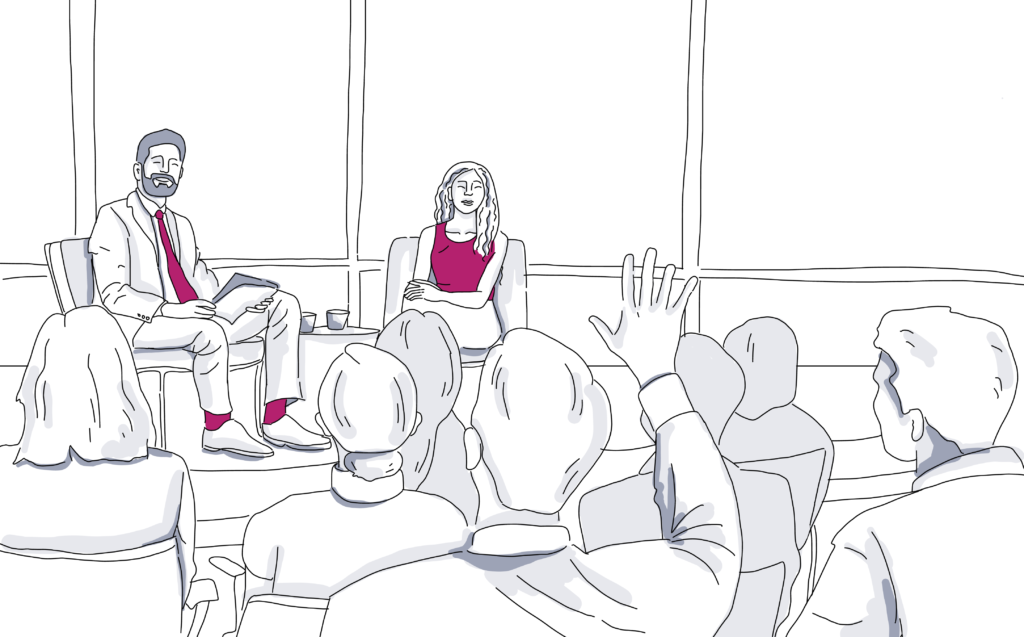
Tips Tuesday: 21 Event Seating Ideas & Trends
While an event’s schedule, venue, and food play a major role in determining the guests’ experience, the event’s seating is just as important. It can determine how guests interact with one another, retain information, and how energized they feel throughout the day. Get ahead of the curve and impress your attendees with these hot seating trends that are revolutionizing events.
Discover The Most Creative Event Seating Trends & Tips
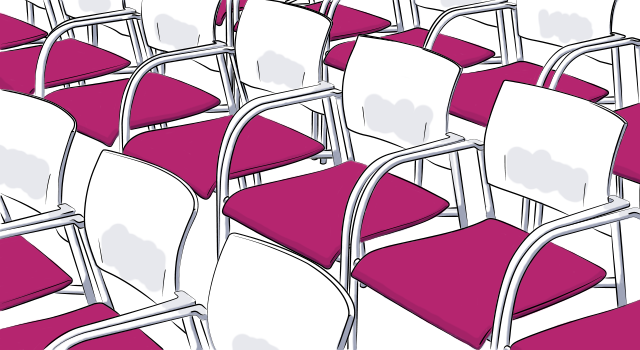
1. Create a casual vibe that allows for mingling and conversation.
Your attendees will be able to fully absorb the purpose of your event if they feel relaxed and comfortable. Encouraging guests to acquaint themselves with one another will increase the levels of participation in the conversation, help them get the most out of their networking efforts, and improve their content retention.
2. Break up large seating sections into smaller sections so people can move around.
Sitting for long periods of time is uncomfortable and can negatively impact an attendee’s experience. Reassure them that moving around to stretch their legs, get a drink, or grab a snack is allowed by arranging the space accordingly. Having smaller sections of seating will prevent attendees from awkwardly weaving around chairs and tables or disturbing others while they are trying to make their exit.
3. Make sure each part of your space is visible so participants can feel safe.
Safety is always at the forefront of your mind and your guests may think about it more than you realize. Allow them to leave their fears at the door by making the entire space visible. This includes clearly marking the exits and routes to the stairwells. In case of an evacuation, guests will have an understanding of the plan and won’t have to navigate an unfamiliar floor plan. Also, keeping your space visible helps ensure that everyone can be seen at all times and no funny business is happening in dark corners or behind extra walls.
4. Use advanced technology to map out your seating options.
Get an accurate layout every time by using a 3D event diagram software. It will help you save time and determine the most efficient floor plan. You can account for the precise measurement of furniture and objects, so the layout is entirely based on your custom needs. Furthermore, the software allows you to plan the event from a birds’-eye view but experience it as if you were a guest with virtual walkthroughs.
5. Include dedicated relaxation stations in your seating plan with some cozy furniture.
Even the most young and fit among your guests may need a minute off their feet or out of a standard chair to unwind. Add some comfortable and quirky seating to ensure they do just that. Taking a few moments for themselves will help them prevent burnout after they receive hours of information from speakers, leaving them re-energized for more sessions.
6. Host a charging station on the outskirts of your event seating plan.
Your guests will have their cell phone, tablet, or laptop (or all of the above) on hand. Give them a place to charge these devices so they can stay connected while attending your event. Placing charging stations away from the main focus of your event seating plan will give guests an opportunity for some down time. It gives them the opportunity to recharge their brains and creativity along with their devices. It will also help other guests stay focused on the main event, since they won’t become distracted by the movement of their peers searching for an electric outlet.
7. Decrease registration area size to make room for additional event seating.
The best way to make the event check-in process a breeze is to implement tools that speed up the process, decrease lines, and free up some floor space for other event staples. With cloud-based check-in software, you can check attendees in using any device, so there’s no need for large desk areas. You can even start using virtual support desks, which will allow you to cut down on staff – a big space and cost savings for you.
8. When in doubt, choose circles over straight lines.
Utilizing round tables and arranging the seating in arches has many benefits compared to traditional theatre style arrangements. Theatre style seating limits conversations – participants can only speak to the people directly next to or behind them. Circular seating patterns, on the other hand, allow small groups to form and encourage conversation because everyone can comfortably see each other without too much extra or disruptive movement. Round tables also eliminate the need to find the best seating in the room because all vantage points are equal.
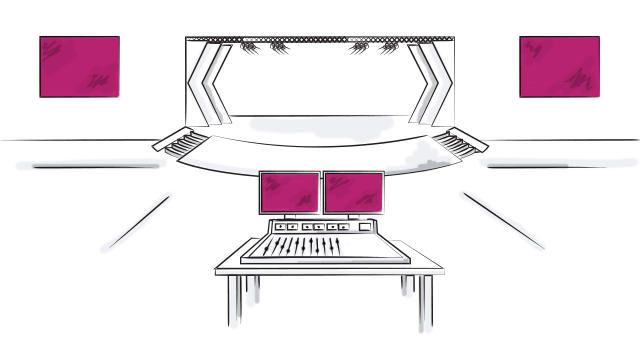
9. Prioritize round table or circular seating arrangements to foster community.
Circular seating arrangements will encourage attendees to engage with the entire group of people they are sitting with. When attendees are participating with one another, diverse perspectives will be brought into the conversation, which gives your guests the opportunity to learn more from their peers.
10. Mix in some unconventional furniture.
Highlight your creative side by including unique seating in the plan! Take a note from trendy office spaces that are incorporating big bean bag chairs and chaise lounges into their spaces. If an outdoor area is available, place branded lounge chairs in shaded spots so people can enjoy the weather for a few minutes. You can even bring in pop up swing sets, which will definitely brighten your guests’ day and make for a fun photo op!
11. Base seating arrangements on direct audience feedback.
For example, if the event audience members you surveyed ahead of time are looking to network at your venue, seating arrangement needs to be easy to navigate, provide a variety of moods, and make it so participants can still comfortably stand and join in conversations as they walk by. But if your audience members are focused on learning from lecturers, a stage with strategically placed seating will need to be incorporated to help them focus on the individual speaking.
12. Use multifunctional furniture pieces.
To achieve a relaxed vibe in your event, incorporate unique pieces such as multifunctional furniture. Break large sectionals up into several parts, spread strategically around a rug for a cozy living room vibe. Offer stools that function as both seating and low level tables for guests to rest their laptops on. Or, you can even try side tables that flip up to work as slim, lightweight desks.
13. Arrange a kickback lounge area complete with couches and greenery.
By bringing home design aesthetics such as comfortable seating and plants into conferences and other corporate events, you’ll create a casual ambience that is on trend for the coming year. This style highlights your desire to make the event experience as enjoyable as possible for your guests. Customer experience oriented details like these are especially helpful with attendance at repeat events because guests will know they can expect to feel great when they’re there.
14. Know your event lighting needs before finalizing your seating arrangement.
Ensure all guests have proper lighting for their tasks before settling on your final seating arrangement. Most convention halls and traditional event spaces should have this all laid out for you but if you plan to go with a venue a little off the beaten path you’ll need to make do a walkthrough at the same time as when your event will take place. And if your event is in the early evening, make sure you do an additional walk through if you expect changes in daylight because of seasons shifting.
15. Add well–being tools to your seating arrangement.
Wellness and self-care continues to be on the minds of many people – including your guests! Provide them with opportunities to stretch their bodies and minds by giving them access to tools for exercise. For example, add a yoga mat area for stretching to your layout or replace desk chairs with exercise balls.
16. Consider hosting lectures outdoors.
Help your guests enjoy the great outdoors by helping them find seating they can comfortably get in and out of without ruining their nice outfits. Whether you choose to add folding chairs, bean bags, or hammocks, make sure you add your outdoor event design to your event software as well to keep things organized.
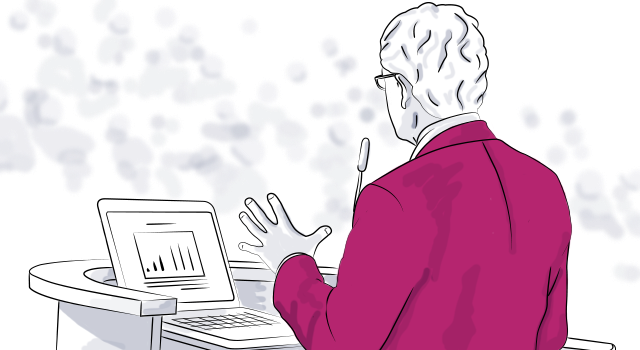
17. Try mixed and matched furniture in monochromatic color scheme or identical pieces in a rainbow of colors.
Add an immediate wow factor to your decor with this trend! It’s ideal if you are working with a small budget because you can make a big impact with just a few pieces.
18. Be bold with assigned seating.
While this tactic may catch guests by surprise, it offers a multitude of advantages. Assigned seating mixes up the attendees so they can connect with individuals they might not otherwise have met. It also allows for the opportunity to place individuals from various career levels together. Additionally, small group discussions will be more vibrant with a mash up of various perspectives.
19. Add a variety of eye levels to your seating arrangements.
To make your event decor visually interesting, combine seating with various height levels. High top chairs can be blended with regular tables or even couch seating. This will naturally create different and clearer view points for audience members without having to use risers.
20. If outlet accessibility is a concern, add some wireless charging cubes to your seating arrangements.
Wireless charging is becoming more and more common in the devices we use every day. The good news is, this type of charging station is small and can be added throughout your seating plan with ease. Furniture with built-in charging cubes are a great bet too. Strategically place these seats or charging cubes throughout your seating plan where you notice outlet access is lacking.
21. Mix traditional seating arrangement elements with unexpected ones.
To implement this flexible event space trend, combine a variety of seating (such as lecture-style seating and soft seating) to add visual interest to the space. One advantage of this layout approach is that it offers guests the opportunity to move around and experience the event from different viewpoints. This furniture can also serve as the bulk of your decor if the pieces are varied enough!
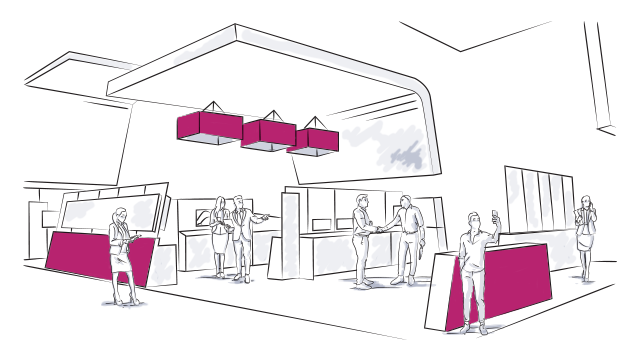
Now you’re ready to plan your next seating chart!
Before you go, take a look at these additional 5 tips for an almost perfect seating plan and find out how you can apply layout design to create a happier office space. Then, see how you can make your client’s wedding day the happiest day of their life with the perfect wedding seating chart.

